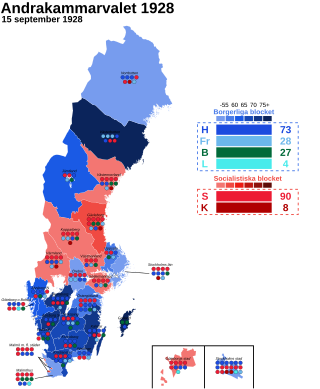
General elections were held in Sweden between 15 and 21 September 1928. The Swedish Social Democratic Party remained the largest party, winning 90 of the 230 seats in the Andra kammaren of the Riksdag. Arvid Lindman of the General Electoral League became Prime Minister, replacing the incumbent, Carl Gustaf Ekman of the Free-minded National Association. The elections have since become known as the "Cossack Election" due to the harsh tone and aggressive criticism used by both sides.

General elections were held in Sweden on 17 and 18 September 1932. The Swedish Social Democratic Party remained the largest party, winning 104 of the 230 seats in the Andra kammaren of the Riksdag. The party returned to government after six years in opposition, marking the beginning of 44 years of near-uninterrupted rule. This was also the first time the socialist parties received an overall majority of the elected parties' popular vote, although the Hansson cabinet still required cross-aisle co-operation to govern since the centre-right parties won 118 out of 230 seats.
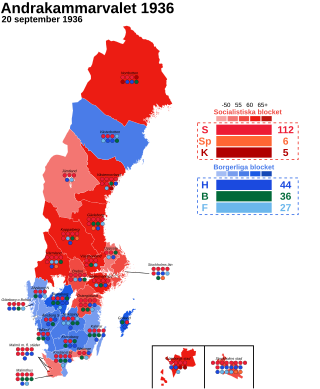
General elections were held in Sweden on 20 September 1936. The Swedish Social Democratic Party remained the largest party, winning 112 of the 230 seats in the Andra kammaren of the Riksdag.

General elections were held in Sweden on 15 September 1940. The Swedish Social Democratic Party remained the largest party, winning 134 of the 230 seats in the Andra kammaren of the Riksdag. It is one of two general elections in Swedish history where a single party received more than half of the vote.
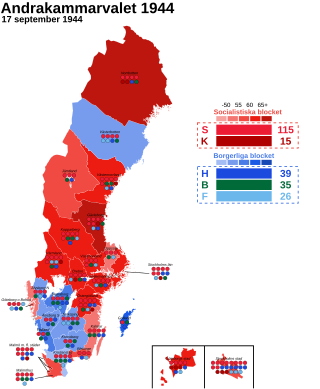
General elections were held in Sweden on 17 September 1944. The Swedish Social Democratic Party remained the largest party, winning 115 of the 230 seats in the Andra kammaren of the Riksdag. Due to World War II, the four main parties continued to form a wartime coalition, only excluding the Communist Party.

General elections were held in Sweden on 19 September 1948. Despite a campaign by a large part of the Swedish press against socializing insurances, controlled foreign trade and rationing regulations still in use since the war, freshman Prime Minister and Social Democratic leader Tage Erlander managed to defeat the People's Party-led opposition under Bertil Ohlin by a higher election turnout. He maintained his government with only minor losses and the Swedish Social Democratic Party remained the largest party, winning 112 of the 230 seats in the Andra kammaren of the Riksdag. Erlander was to stay on as Prime Minister until 1969.
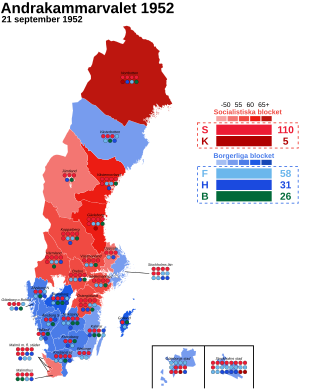
General elections were held in Sweden on 21 September 1952. The Social Democrats remained the largest party with 110 of the 230 seats in the Andra kammaren of the Riksdag and together with the Communist Party of Sweden they got 115 seats and the other parties 115 seats. Tage Erlander and his Social Democratic Party did however form his second government with the Farmers' League already in 1951 and together with that party the Social Democrats now had a majority of 136 seats in the chamber and together with the Communists 141 seats. In the other indirectly elected chamber the Social Democrats had an absolute majority.

General elections were held in Sweden on 16 September 1956. The Swedish Social Democratic Party remained the largest party, winning 106 of the 231 seats in the Andra kammaren of the Riksdag. A Social Democratic-Farmers' League coalition government was formed by Prime Minister Tage Erlander after the election with 125 of the total of 231 seats. Although the non-socialist parties held a majority in the Second Chamber, the Social Democrats held a majority in the First Chamber, so a non-socialist government could not be formed.
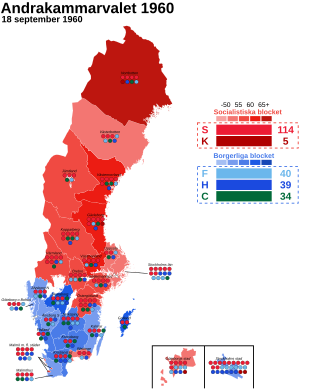
General elections were held in Sweden on 18 September 1960. The Swedish Social Democratic Party remained the largest party, winning 114 of the 232 seats in the Andra kammaren of the Riksdag.

General elections were held in Sweden on 20 September 1964. The Swedish Social Democratic Party remained the largest party, winning 113 of the 233 seats in the Andra kammaren of the Riksdag. Tage Erlander's Social Democratic government was returned to power.

General elections were held in Sweden on 15 September 1968. Held in the wake of the crushing of the Prague spring, it resulted in a landslide victory for the Social Democratic government and Prime Minister Tage Erlander. It is one of two general elections in Swedish history where a single party received more than half of the vote. Erlander would resign the following year after an uninterrupted tenure of 23 years as head of government.
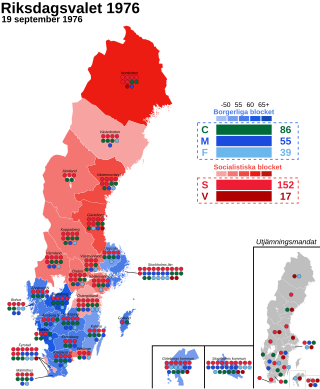
General elections were held in Sweden on 19 September 1976. Although the Swedish Social Democratic Party remained the largest party, winning 152 of the 349 seats in the Riksdag, a coalition government was formed with the Centre Party, the People's Party and the conservative Moderate Party, which formed Sweden's first non-socialist government since 1936. Centre Party leader Thorbjörn Fälldin, who had widely been expected to take over the government in the previous election of 1973, was appointed Prime Minister, the first not from the Swedish Social Democratic Party since Axel Pehrsson-Bramstorp's brief interregnum 40 years earlier.

General elections were held in Sweden on 16 September 1979. Although the Swedish Social Democratic Party remained the largest party, winning 154 of the 349 seats in the Riksdag, the liberal interim government of Ola Ullsten was succeeded by another centre-right coalition government composed of the People's Party, the Moderate Party and the Centre Party, led by Centre Party leader Thorbjörn Fälldin. The three parties together won 175 seats, compared to the 174 won by the Social Democrats and Communists. It was the only time that non-socialist parties retained power in an election between 1928 and 2010. The Moderates dramatically increased their representation in the Riksdag, becoming the largest party of the non-socialist bloc, a position they maintained until 2022.
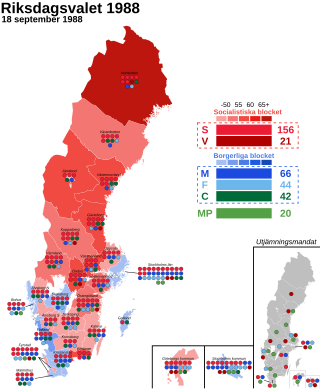
General elections were held in Sweden on 18 September 1988. The Swedish Social Democratic Party remained the largest party in the Riksdag, winning 156 of the 349 seats.
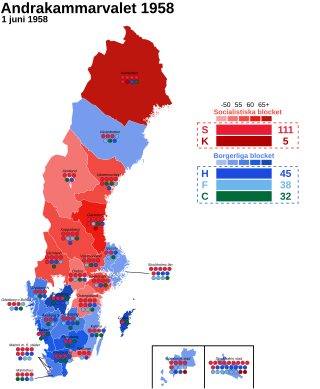
Early general elections were held in Sweden on 1 June 1958, after the defeat of the Social Democratic government's proposals for a new pensions system in a parliamentary vote. The Social Democrats remained the largest party, winning 111 of the 231 seats in the Andra kammaren of the Riksdag, and Tage Erlander's third government was returned to power. In accordance with the law, the new Chamber was elected only to complete the previous Chamber's term, which was due to end in 1960.
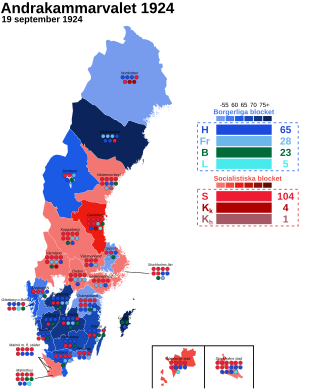
General elections were held in Sweden between 19 and 21 September 1924. The Swedish Social Democratic Party remained the largest party, winning 104 of the 230 seats in the Second Chamber of the Riksdag.

Early general elections were held in Sweden between 27 March and 7 April 1914, after the Riksdag had been prematurely dissolved by the Cabinet of Hjalmar Hammarskjöld. The General Electoral League emerged as the largest party, winning 86 of the 230 seats in the Second Chamber. As of 2022, this is the last time a Swedish election has not seen the Social Democrats win a plurality of seats.

Early general elections were held in Sweden 5 and 13 September 1914, the second that year. Although the General Electoral League received the most votes, the Swedish Social Democratic Party emerged as the largest party, winning 87 of the 230 seats in the Second Chamber, and have managed to remain so in every subsequent Swedish election.

General elections were held in Sweden between 1 and 16 September 1917. The Swedish Social Democratic Party remained the largest party, winning 86 of the 230 seats in the Second Chamber of the Riksdag. As a result the Rightist Prime Minister Carl Swartz resigned the premiership and was replaced by Liberal leader Nils Edén.

General elections were held in Sweden between 4 and 17 September 1920, the last before universal suffrage was introduced the following year. The Social Democratic Party remained the largest party, winning 75 of the 230 seats in the Second Chamber of the Riksdag. Later in October 1920 Hjalmar Branting was succeeded as prime minister by Baron Louis De Geer.




















